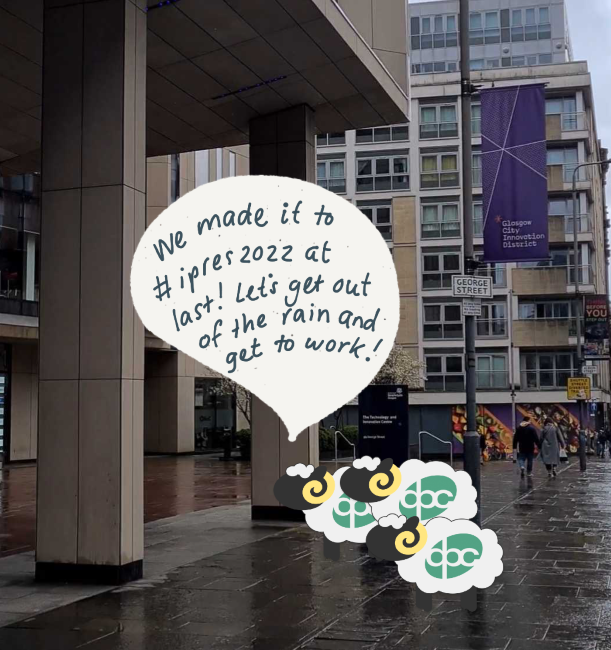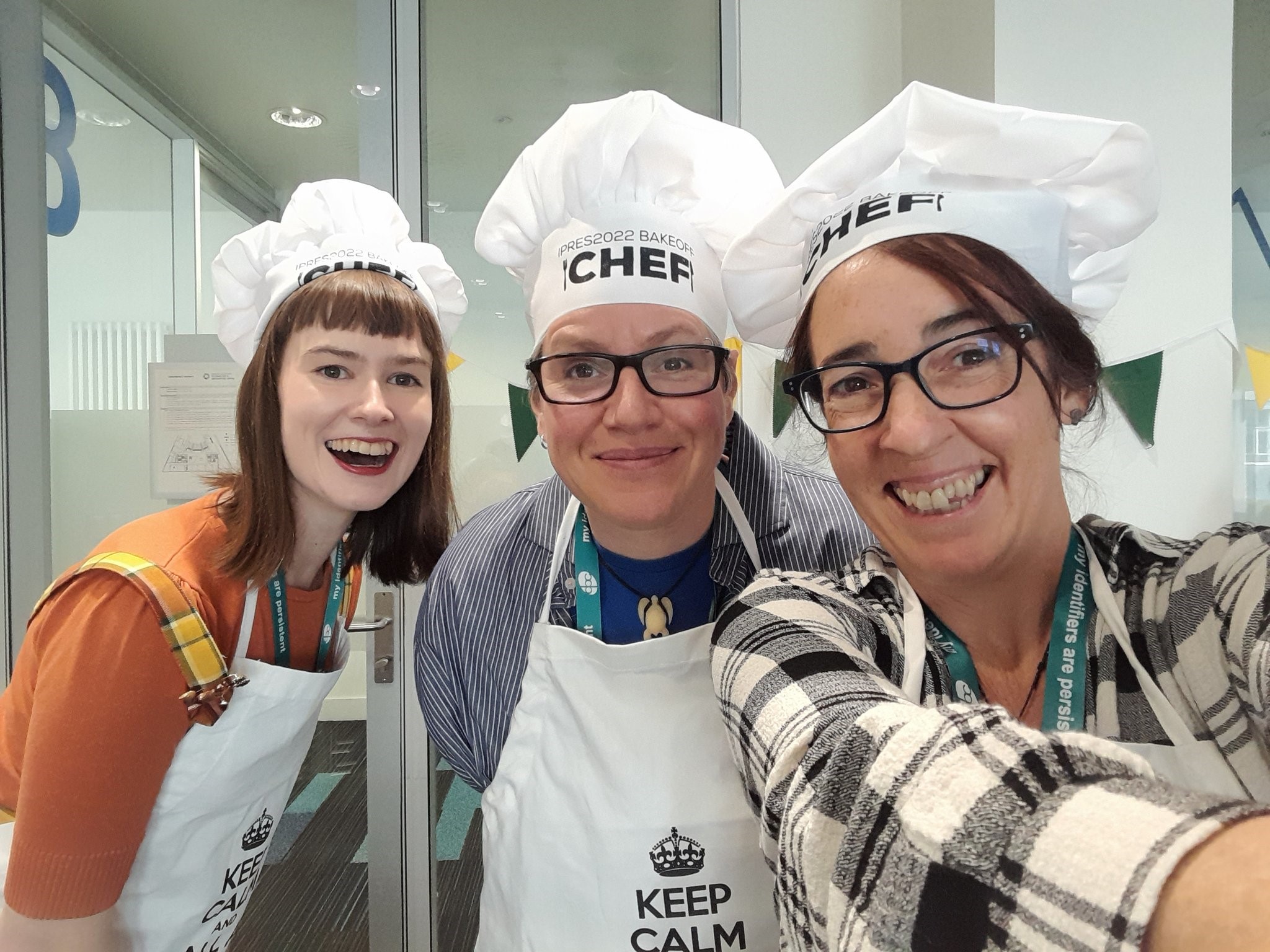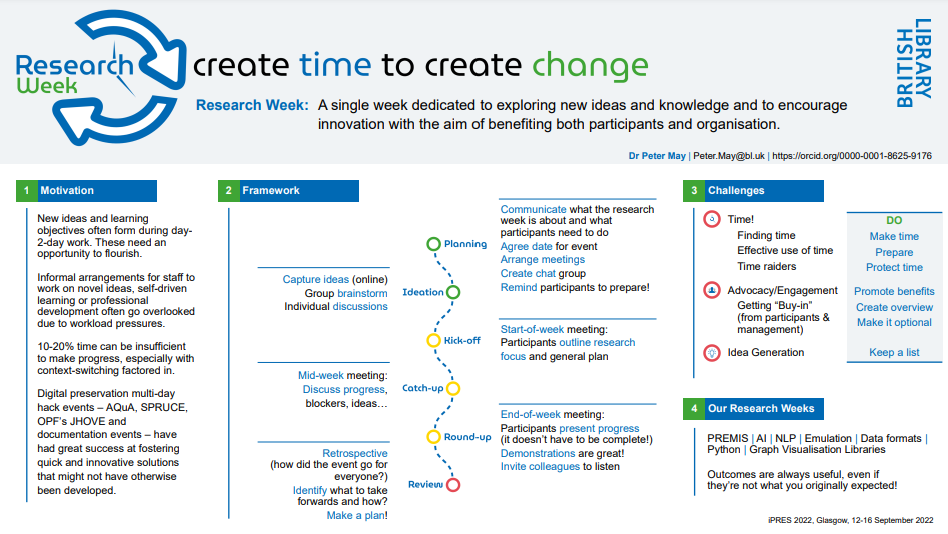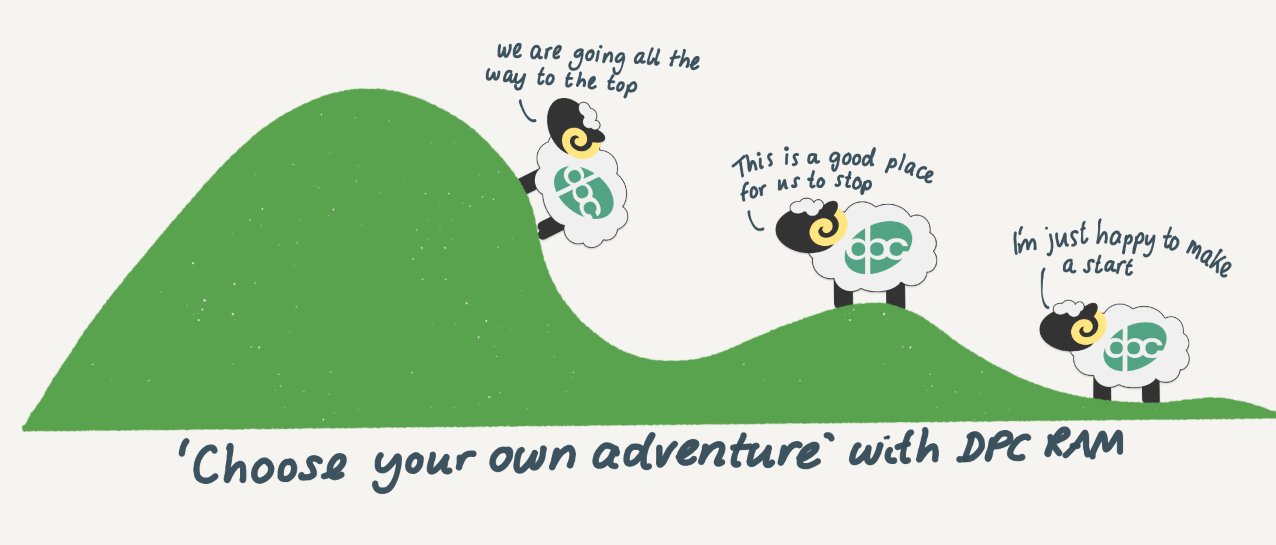Ever since returning from Glasgow last month I have been meaning to get my thoughts down on my own iPres experiences. Writing this post has been a good way for me to organise my own thoughts and learnings from the conference and also a good excuse to dip into some of the written proposals and presentation recordings, but I think the time spent has been worth it. This is an account of how iPres was for me!
Firstly, I can not stress enough how great it was to attend a face-to-face conference again after all of this time. The last conference I went to was in February 2020. That seems like an absolute age ago. Despite what we have been able to replicate on Zoom, I’ve really missed face-to-face interactions with the digital preservation community and it was wonderful to be able to stand in a room full of people and see people I recognised whichever way I turned as well as new acquaintences to make.
I was surprisingly nervous (perhaps this isn’t such a surprise) of presenting to a real live audience again. I haven’t exactly relished giving presentations over zoom, but I had got into a pattern of doing things slightly differently online, and wasn’t sure how easily I would get back into the old routine of presenting 'in real life'. I think once the nerves calmed down I concluded it was actually nice to have a live audience again. I have missed being able to pick up on the atmosphere in the room, see faces and hear reactions and it was lovely to be in a space where applause was audible rather than a series of emojis (much as I love the non-verbal reactions too)!
So here is a day by day run down of my own iPres experience.
DAY ONE
The first morning of the conference was taken up with a workshop on Continuous Improvement Tools for Developing Capacity and Skills with my colleagues Sharon McMeekin and Amy Currie. For me, this was a valuable opportunity to share our Rapid Assessment Model (DPC RAM) with a new audience and also the first outing of my new ram earrings (congratulations to the two people who noticed them!). After an introduction on the importance of continuous improvement from Sharon, I dived into an introduction to DPC RAM and then we had time (perhaps not enough time....!) for attendees to try RAM out for themselves. This was a hybrid workshop session with many people in the audience in Glasgow and an equal number joining online and it worked well to use Mentimeter to do some anonymous benchmarking and feedback afterwards. This was a nice tool for a hybrid environment, with the online participants to be able to engage on the same level as the audience in the room.

DPC RAM arrives at the TIC at last (I don't actually think it was raining)
The results of the poll showed that the majority of people in the room were trying out DPC RAM for the first time so it was great to be bringing the model to a new audience. It was good to see in the follow up questions that the majority of attendees intended to continue to work on their RAM assessment after the workshop, as well as using it for other purposes. The last question I asked was ‘How did you find using DPC RAM?’ - the top words that came out in the free text answers were ‘useful’, ‘easy’, ‘clear’, ‘practical’ and ‘intuitive’ - this was all really encouraging to see.
The RAM section of this workshop was followed by a section focusing more specifically on a newer tool from the DPC. Digital Preservation Competency Framework and associated Competency Audit Toolkit (CAT) for assessing digital preservation skill levels. It was great to see attendees getting hands on with skills assessment and actively considering how they might use this framework within their own organizations. Of course, the point was also made that DPC RAM and CAT can be used together to provide a more comprehensive assessment and gap analysis within an organization and hopefully workshop attendees were well equipped to go away and do just this!
On Monday afternoon, I chaired an online tutorial with Kerstin Arnold on Automated Topic Modelling In Archives Portal Europe. It was nice to be able to engage a bit more with the online conference attendees and it was an interesting session in which Kerstin described the tricky challenge of enabling successful cross-searching across multiple archives in different languages and introduced an AI tool for automated topic detection to enable better search and retrieval. Participants had some time to test out the search facility and to provide feedback.

Back on Zoom for an afternoon tutorial (with refreshments)
DAY TWO
Tuesday was another busy day for me. The first keynote of the conference was from Amina Shah from the National Library of Scotland. Video Killed the Radio Star: preserving a nation’s memory was really all about continuity and change. As well as grabbing our attention with a memorable hit from 1979 (and a retro music video), she shared some great archival footage and talked about the importance of storytelling and advocacy in digital preservation.
Next, I went on to facilitate a panel session about computational access called Computational Access to Digital Material: Exploring topics around engagement, ethics and resources which had been put together with Leontien Talboom from the University of Cambridge. It was brilliant to be joined by James Baker (University of Southampton) and Sonia Ranade (The National Archives, UK) and after a quick introduction to the topic and to our recently released Beginners Guide to Computational Access, I fired questions at the panel on the topics of getting started, engaging with stakeholders, working with users and (of course) ethics. It was a great chat, with some real pearls of wisdom coming from the panelists. The 45 minutes really flew by!
On a similar theme, our panel was followed by a presentation from Abigail Potter and Meghan Ferriter from the Library of Congress Feasible, Adaptable and Shared: A call for a community framework for implementing ML and AI. Hats off to Abigail, who was quite literally, fresh off her (delayed) flight and arrived at the TIC just in time to give this joint presentation! They described their work around experimentation and talked about the need for a collective conversation and sharing of stories about what does and doesn’t work. They talked about the need for documentation, the need for transparency and the need to increase staff literacy in these areas. Inspired by the simplicity of the NDSA Levels of Preservation, they are keen to produce a framework for Machine Learning and Artifical Intelligence and called for the audience and wider community to help them produce this. This was a really great paper, highlighting some important and innovative work which will benefit the wider community.
After lunch I was straight into presenting a paper I had written with colleague Paul Wheatley to provide insights from our first three years of working with the community with our Rapid Assessment Model (DPC RAM) - Going for Gold or Good Enough? Observations on three years of benchmarking with DPC RAM. In this talk I shared some very high level findings from working with DPC Members using this model over the last three years and then made seven observations - for example on the challenges of standing still in the midst of a global pandemic, on the ‘choose your own adventure’ style of the DPC RAM model and on the length of time it actually takes to implement digital preservation. I’d love to be in a position to come back to iPres in the future and talk about learnings from the first ten years of DPC RAM with some more solid observations but let’s not get ahead of ourselves…
DPC RAM encourages you to work out where to aim for and to a certain extent, how you want to get there
After my talk the other papers in that session continued on the theme of measuring capability and progress in digital preservation. Firstly, Jessica Tieman on A decade of Trustworthy Digital Repository Certifcation: Yet there was one. This paper gave a really interesting insight into the U.S. Government Publishing Office and their experiences and decision making around certification. Having achieved and maintained ISO16363:2012 certification for the last ten years, they were concerned that the rest of the digital preservation community was not embracing this particular method of certification and a decision was made to pursue CoreTrustSeal as an additional form of certification more closely aligned with the international digital preservation community. Jessica talked about the perceived benefits of achieving a dual model of assessment including the need for publicly available documentation and the improved opportunities for engagement with the wider community.
Next up, sticking to the topic of CoreTrustSeal, Hervé L'Hours and Jonathan Crabtree discussed CoreTrustSeal v3.0 In a Preservation and Community Context. In this session, they gave an interesting insight into the revision process for CoreTrustSeal and discussed some of the changes that are to come in version 3.0. Having personally been involved in revisions of other models and frameworks (DPC RAM and the NDSA Levels of Preservation) it was really interesting to hear about how revisions are made to a formal certification standard like CoreTrustSeal and I was encouraged to hear the extent to which the community consultation and collaboration is involved in the process.
At the end of a pretty hectic day, it was a pleasure to sit in on the Lightning talks (always one of my favourite bits of a conference) to hear from a whole range of people about a variety of different topics. So much good stuff to report on, but stand out talks for me were from:
-
Sibyl Schaefer and Eld Zierau on the Preservation storage criteria - version 4 of this incredibly useful community resource is coming soon and includes standards mapping as well as new and revised criteria.
-
Teagan Zoldoske on a High Speed 2 case study from the Archaeology Data Service - a real world case study around what you do when you don’t get the metadata that you require.
-
Steve Daly from The National Archives, UK on some new developments with PRONOM - PRONOM is now 20 years old and they have decided to update it to make it more accessible and secure. The team that manage PRONOM are keen to engage with the community to ensure it meets everyone’s needs.
-
Elizabeth England on NARA’s file format preservation action plans and recent collaborative work with linked data.
DAY THREE
Wednesday was another great day which got off to a good start with another excellent keynote presentation. This keynote was from Tamar Evangelestia-Dougherty, Director of Smithsonian Libraries and Archives on Digital Ties that Bind: Effectively Engaging with Communities for Equitable Digital Preservation ecosystems. As well as sharing some of her personal story, she shared the stories of community archivists that she has had the pleasure to work with and stressed the challenges for community archivists who often don’t feel supported or included by those of us who are established in digital preservation. She talked about the fact that collections are best when centred within their communities and that there are communities out there who are doing a great job. She also shared tips on how we can engage better - for example, seeing community archivists as our colleagues (not just people we are helping), being honest about what we can deliver, and creating opportunities (and perhaps we should start by ensuring they can come to conferences like iPres!)
The rest of Wednesday for me was all about the Great Digital Preservation Bake-off. I had been recruited as one of the judges for two of the Bake-off sessions. I hadn’t known quite what to expect but left the sessions both enlightened and entertained. The Bake-off saw perhaps as many as 15 different tools being demonstrated in snappy and good humoured, ten minute presentations (and sometimes even live demos!) and we saw a good mixture of systems and tools - both those that carry out a very specific task in the digital preservation workflow and full digital preservation systems. The ‘bakers’ (presenters) who were demonstrating their ‘dishes’ (tools) did a great job of embracing the theme and were all awarded an commemorative wooden spoon as a prize. Despite there being "no actual baking", there were actual cakes (in huge quantities!).
Actual cake at the Digital Preservation Bake-off!
A couple of observations, coming out of these Bake-off sessions: Firstly, how amazing it is that the community has so many enthusiastic individuals who are prepared to create and maintain tools which are free for others to use; Secondly, how good it was to see tools building on and reusing the outputs of other tools. This seems like a healthy ecosystem, but one of the points raised on the day was how can we better support open source tools in this community. So many of the tools demonstrated rely on the good will and vision of a few talented and enthusiastic individuals. Is this really sustainable and can we do better?

With some of my fellow Bake-off judges Micky Lindlar and Leontien Talboom
DAY FOUR
On the Thursday of iPres I had no responsibilities and enjoyed the opportunity to just sit and absorb all that the programme had to offer. In the morning I was keen to support my colleague Michael Popham and hear his paper on our digital preservation project with the UK Nuclear Decommissioning Authority (read more on our project here). This was followed by another paper from the nuclear industry on Passive Digital Preservation on Paper in Practice by Vincent Joguin. This was an interesting paper that slightly blew my mind. Vincent described the results of transcribing a database concerning radioactive waste packages onto paper, producing a 464-page document instead of a million pages that plain text printing would have required. The methodology described was a form of file storage on paper - a way of storing binary files in the form of 2 dimensional printed barcodes, thus hugely reducing the amount of pages you would need if you were to ‘just print it all out’. The information stored in the barcodes contain all that is needed to recreate the actual databases and tests have demonstrated that the database can indeed be recreated by computer scientists not associated with the project.
A highlight of the morning for me was a panel session convened by Paul Stokes of Jisc, Its all important of course but… Paul had brought together a great group of speakers to do quick elevator pitches for the element of digital preservation that they felt was most important. I found this approach to a panel to be really engaging and thought provoking and it was so good to hear such a range of perspectives from different members of the community. I think I most strongly agreed with Elisabeth Thurlow of University of the Arts London who talked about the need to collect less (due to environmental issues) and the importance of being able to demonstrate value against the cost; and Kirsty Lingstadt of the University of York who argued that advocacy was the most important digital preservation activity - following on from Amina Shah’s keynote, she talked about storytelling as a really powerful advocacy tool and noted that without a clear understanding of why something is important stakeholders will not engage and enable you to make progress.
There was some great discussion with the audience (both online and in the room) and in particular it was good to hear from Keith Pendergrass of Harvard Business School who reiterated the environmental angle as being the most important thing for us to take into consideration and Patricia Sleeman of UNHCR who gave a convincing elevator pitch for people being the most important thing. I actually think she won over practically everyone in the room (note to self - invite Patricia on to the next panel session I put together)!
I also took some time to look at some of the posters that were on display (unfortunately I missed Wednesday’s posters). It was an interesting and varied selection but if I had one highlight it was the poster from Peter May of the British Library which neatly described and illustrated the concept of the ‘Research Week’ as tested out in his department. The research week is intended to enable staff to focus on digital preservation related work or training they have lacked the core time to do and also aims to create time for staff to innovate. It is a simple idea, and something that perhaps would translate well to many other organizations.

Do check out Peter May's poster on Research Week at the British Library
The last keynote of the conference was another highlight for me. Steven Gonzalez Monserrate, from MIT presented on After the Cloud - Rethinking data ecologies through Anthropology and speculative fiction. Steven is a fabulous storyteller and got me hooked right from the beginning. Acknowledging that preservationists are no strangers to time travel, he took us back in time to 1000CE when the Quipu was what he described as ‘the world’s first cloud’. He went into a discussion about why ancient ‘computers’ like this survive and why digital today is so fragile. He talked about his own ethnographic work at data centres and their huge impact on both people and the environment. He went on to look at speculative fiction as a means to paint a picture of a different (and better) future. He ended on a powerful note by saying we need to make a choice between preserving our history and killing our planet. This was such an important message to effectively end the conference on and drew on a key theme from several of the other sessions over the four days.
After iPres
Many of the sessions from iPres were recorded and some of these were immediately available on the online platform. Given the packed programme and very real FOMO I know we all experienced when trying to decide which conference room to head to, it has been good to be able to watch back some of the sessions that I missed. The thing I'm most sad I missed (and can't really catch up on) are the digital preservation games - after claiming in a previous blog post that you would be able to find me in the games room, I failed to even get my foot in the door due to other commitments...sigh...I hope to do better next time.
I have a couple more highlights to share after watching a selection of recordings…
-
Green Goes with Anything: Decreasing Environmental Impact of Digital Libraries at Virginia Tech, Alex Kinnaman and Alan Munshower - an award winning paper (rightly so!) and well worth checking back on if you haven’t already. This excellent presentation is really packed full of useful information as the authors discuss how their institution has been working out how to shift to more sustainable practices. Activities have included looking at the energy costs of fixity checking (and even the differing costs of using specific checksum algorithms) and looking at the environmental impact of their storage infrastructure. They discuss going against industry standards around resolution and bit depth for digitisation activities and the importance of appraisal at every stage in their workflow. I might go so far as to call this paper ‘essential reading’ for those of us working in this field…
-
Preservation Watch: Working Towards A Supra-Organizational Preservation Watch Function Within The Dutch Digital Heritage Network, Lotte Wijsman, Tamara van Zwol and Eva van de Hurk - this was a really interesting paper on a challenge that I know will be of interest to the whole community - how do we do ‘preservation watch’? The authors talked about how preservation watch activities can be ‘more than just a day job’ and of the potential of working together on it as a community. They set out the scope of their collaborative preservation watch activities in the Netherlands (covering file formats and tools, metadata standards and storage techniques) and demonstrated the platform they are using to gather and share information. Not surprisingly, discussion moved quickly to how this work could be made more international - I think there are many non-Dutch-speakers who would love to be able to benefit from the findings of these preservation watch activities. I’ll be interested to see how this work develops going forward.
...I mean I could go on…there was lots of other good stuff, and I think lots more recordings (and the full proceedings) still to be made available, but I don’t think this blog needs to get any longer. My iPres was great and has left me with so many new contacts and ideas. I haven’t even touched on the social activities and my experiences on the dancefloor at the conference dinner (I genuinely don’t think I’ve laughed as much in ages). I really hope I don’t have to wait another two and a half years before attending my next face-to-face digital preservation conference!


















































































































































Comments